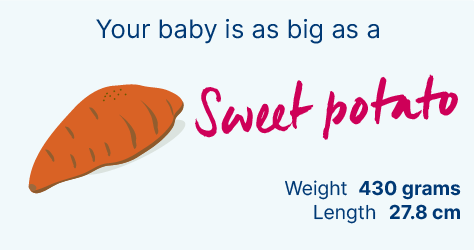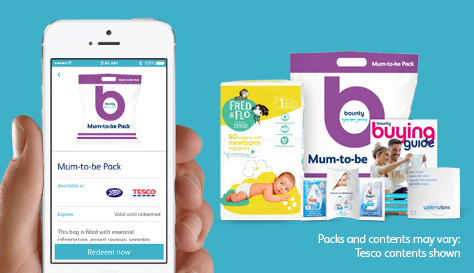At a glance
- Your baby will be developing their own daily routine around now
- You may find your baby responds to your voice
- Think about the organisation of your day-to-day living space

How big is my baby at 22 weeks pregnant?
Your baby is around 27.8cm from head to toe now, about the size of a sweet potato and continuing to grow. Your placenta will also keep growing throughout your pregnancy, providing nourishment for your little one.
Your baby’s taste buds start to develop and there are some suggestions that what you eat now could affect the flavours your baby prefers after they are born, so eat lots of nutritious food.
Amazingly, your baby’s gums are already developing tooth buds, ready for their first teeth to come through a few months after birth.
Their eyes will also have formed, but due to a lack of pigment in their iris they won’t have an eye colour yet. It’s also common for babies to be born with one eye colour but for them to change in the first few months.
Their other organs continue to grow especially their lungs which will continue in the coming weeks and by 24 weeks they could be developed enough to breathe actual air rather than fluid.
Your baby gets all their oxygen from your blood via the placenta until they are ready to take their first breath after they are born - and even though they can’t breathe in the womb, your baby’s practising breathing movements for life outside.
Your baby might be developing their own little daily routine now, and establishing a pattern in their waking and sleeping. It might not be the same as yours though, so be prepared for some middle-of-the-night kicks and mid-morning quiet periods. (all good practice for the coming months!).
Did you know?
- Your baby is around 27.8cm from head to toe now, about the size of a sweet potato
- Your baby will be developing their own daily routine and movement patterns around now
- Your baby's gums are already developing tooth buds, ready for their first teeth to come through months after birth
- Baby will play in the womb (turning somersaults, wriggling around!) and then have a little nap to recover
You at 22 weeks pregnant
You are probably enjoying your baby's movements right now, particularly when they 'perform' in response to your voice if you talk or sing to them, or jump if there is a loud noise or bang.
You might also be enduring 'bump touchers' as your belly becomes more and more obvious – everyone from your work colleagues to the postman wanting to cop a feel of your expanding tummy! Don't be afraid to ask people not to – you are not public property just because you are pregnant.
Puffy ankles and swollen feet can be a problem for some, so be sure to put your feet up whenever you can and to wear supportive and comfy shoes if this affects you. If you wear contact lenses, you might find they are becoming uncomfortable now, as well – speak to your optician for advice if you are experiencing this.
As pregnancy hormones loosen your joints ready for birth, some women experience pain in their pelvis and hips. This is called Pelvic Girdle Pain (PGP) or Symphysis Pubis Dysfunction.
It can begin as early as the first trimester or as late as the last few weeks or days before giving birth. It can be come uncomfortable and even painful to walk, climb stairs or turn over in bed. If you notice symptoms, talk to your midwife of GP straight away. They can refer you to a specialist physiotherapist who can help you manage the condition and show you ways to strengthen your muscles. The sooner you get help, the faster you should recover once your baby is born.
Even if you haven’t any symptoms of Pelvic Girdle Pain it is important to take care of posture and movements getting in and out of bed and wearing supportive footwear is advised by physiotherapists for all pregnant women.
You might also be free of period cramps for 9 months but leg cramps are common in the second and third trimesters – especially at night. Try some gentle calf muscle stretching exercises before bed and keep hydrated. When cramp strikes, stretch the calf muscle and try walking a little and elevating your legs to help keep the cramp from returning. A hot shower, warm bath, ice massage or muscle massage may also help.
Did you know?
- The metabolic energy needed to breastfeed a baby each day is the amount you'd use to walk seven miles
- In Denmark baby names must be approved by the government

Your FREE Mum-to-be pack is ready in the Bounty app
Pack contents vary by retailer


What to think about in week 22 of pregnancy?
It’s not too soon to begin thinking about how to feed your baby. Around 8 out of 10 mums start breastfeeding and although you don’t have to make your mind up until your baby is born here are some of the reasons why:
Breastmilk contains special antibodies which help protect your baby against infections and can help you and your baby bond and get to know each other. It also contains DHA – an omega 3 fatty acid – that helps brain and eye development. Breastfeeding can also help you return to your pre-pregnancy weight quicker.
Obviously you are not going to have to be worrying about fridge locks and baby gates for a while, but you might want to make some changes in preparation for your newborn coming home. For example, where will your travel system live? Do you need to clear out the garage or under-stairs cupboard? Where will your Moses basket go - do you need to re-arrange your bedroom to fit it (or your baby's cot) in?
Think also about the organisation of your day-to-day living spaces - you'll need to make sure that everything is in easy reach for breastfeeding – if the phone is currently at the furthest point in the room from the sofa, you might want to make a few little changes!
You may also be on a mission to get your baby’s nursery sorted and be trying to decide exactly what you need, what you want and of course, what you can afford. But some expectant parents are a lot more laid back about nursery plans and even leave it until after their baby is born – after all, the recommended advice is that your baby sleeps in the same room as you for the first six months. Many new parents choose to have a changing unit. Although far from an essential it can be a handy addition to the nursery.
Of course you can simply lay your baby on the floor to change a nappy using a changing mat, but a changing table will save you a lot of backache!
Most changing units come with a comfy mat and storage underneath too, so you can grab wipes, nappies and clothes with one hand, while holding your baby firmly in place with the other! Some also convert to become plain drawer units which can be handy as your little one grows.
Found this helpful? Read more on...
Signs and symptoms at 22 weeks pregnant
From an innie to an outie
Around this point of your pregnancy you may have noticed your belly button ‘pop’. If you usually have an innie belly button, it may now be looking more like at outie. This is caused by your growing uterus pushing your abdomen forward. Whether you had an innie or an outie to start with, most mums-to-be are sporting an outie in the second or third trimester of pregnancy. This isn’t something you can do anything about, but rest assured, when your baby is born your belly button will return to what it used to be. Although uncommon, sometimes a woman’s belly button can stick out so much that it’s called an umbilical hernia.
Stretch marks
You may soon be noticing some early signs of stretch marks appearing particularly around your bump. Around 90% of mums-to-be get stretch marks, they usually appear on the breasts, thighs and belly and can vary in width from 1-10mm and can be several centimetres long. The do tend to fade over time to look more silvery white in colour rather than red or pink, but they don’t ever go completely. Retaining the skin’s moisture can certainly help their appearance so using oils, creams and lotions regularly is a good idea.
Video 1: What can I do during pregnancy to make birth easier? (From the NHS)

Video 2: Caesareans explained
Video 3: Getting ready for your baby's arrival
Baby Names
Search for a name, sibling names, middle names - or use our random name finder for some creative fun!
Baby Name Search